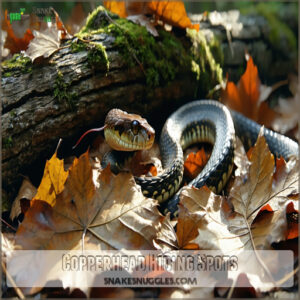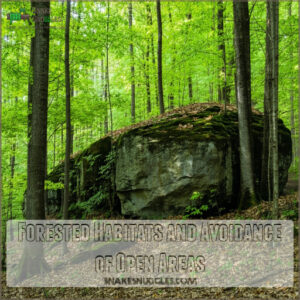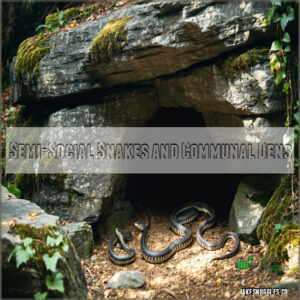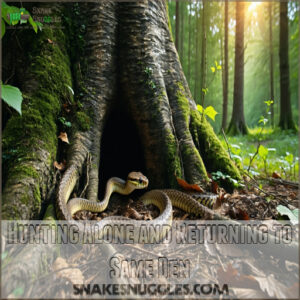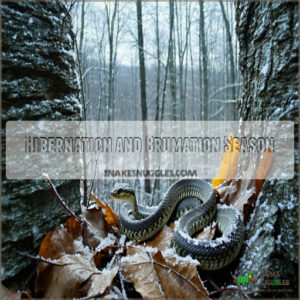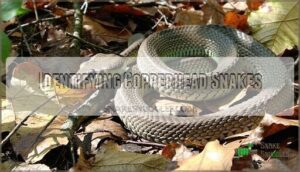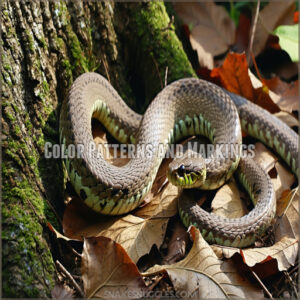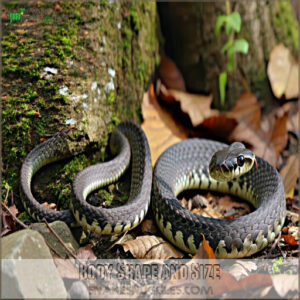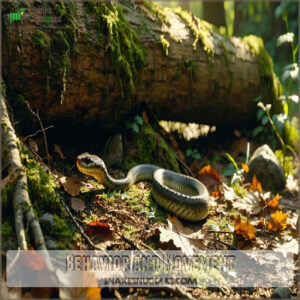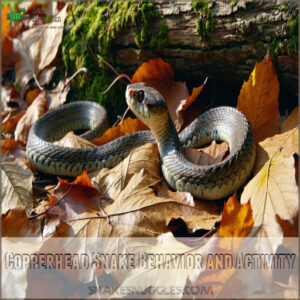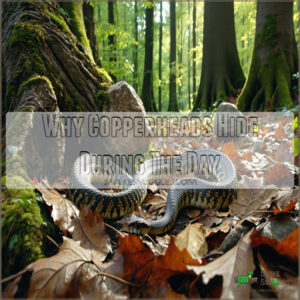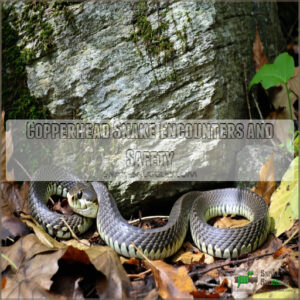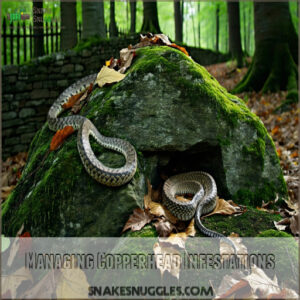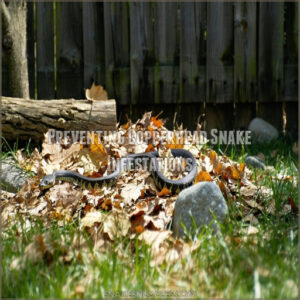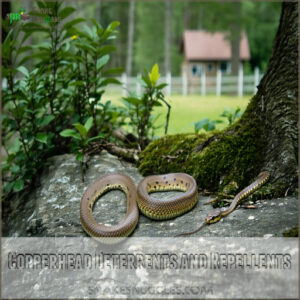This site is supported by our readers. We may earn a commission, at no cost to you, if you purchase through links.
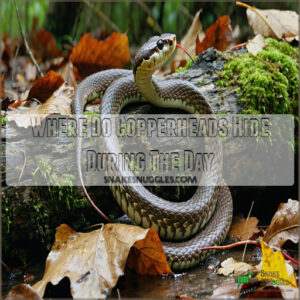
They’re especially fond of south-facing hillsides where forest meets rock, creating perfect spots for their daytime snooze.
Around homes, they might tuck themselves under garden debris or inside stone walls, like nature’s ninjas, they’re masters at finding spots that help them control their body temperature while staying hidden from both prey and predators.
Understanding their preferred hideouts is just the first step in keeping your property snake-free, and recognizing their love to curl up under fallen logs, thick leaf piles, and rocky outcrops where they’re practically invisible thanks to their natural camouflage.
Table Of Contents
- Key Takeaways
- Copperhead Hiding Spots
- Where Do Copperheads Hide During The Day
- Copperhead Habitat and Behavior
- Identifying Copperhead Snakes
- Copperhead Snake Behavior and Activity
- Why Copperheads Hide During The Day
- Copperhead Snake Encounters and Safety
- Managing Copperhead Infestations
- Preventing Copperhead Snake Infestations
- Copperhead Deterrents and Repellents
- Frequently Asked Questions (FAQs)
- How do you know if a copperhead snake is around?
- What attracts copperheads to your yard?
- What time of day are copperheads most active?
- How long do copperheads stay in the same area?
- Do copperhead snakes stay in the same area?
- Do copperheads return to the same hiding spots?
- How far do copperheads travel from their hideout?
- Can multiple snake species share hiding locations?
- What temperature makes copperheads seek shelter?
- How long do copperheads stay in one spot?
- Conclusion
Key Takeaways
- You’ll find copperheads in cool, dark spaces like rocky hillsides, fallen logs, and dense leaf litter during the day, where they can regulate their body temperature while staying hidden from predators.
- Your yard can attract copperheads if you’ve got prime hiding spots like wood piles, garden debris, foundation cracks, or areas under decks and porches where they can remain concealed and hunt for prey.
- You’ll notice copperheads are most active during dawn and dusk, using their natural camouflage to ambush prey while conserving energy in their hiding spots during peak daylight hours.
- You can prevent copperhead infestations by keeping your yard clean of debris, sealing entry points around your home, removing standing water, and installing snake-proof barriers around your property.
Copperhead Hiding Spots
You’ll find copperheads hiding in cool, dark spaces like rocky hillsides, fallen logs, and thick leaf litter during the day.
These venomous snakes also take shelter under garden debris and inside stone walls near your home, making it essential to know their favorite hiding spots.
Rocky, Forested Hillsides
Among rocky hillsides and forest floors, copperheads masterfully blend into their woodland ecology.
These secretive serpents favor south-facing slopes, where terrain features create perfect hiding spots beneath fallen logs and thick leaf litter.
You’ll spot their preferred copperhead daytime habitat in areas where rocky outcrops meet forested areas, creating ideal spots for hillside denning.
During daylight hours, they’re experts at finding shelter between sun-warmed rocks and dense ground cover.
Their natural camouflage makes these copperhead hiding spots nearly invisible to both prey and predators, allowing them to rest undisturbed until dusk.
Understanding their copperhead species profile is essential for appreciating their behavior and habitat preferences.
Wetlands and Semiaquatic Areas
Inside wetland ecosystems, copperheads carve out their daytime retreats near water sources and aquatic plants.
You’ll find these adaptable snakes nestled in semiaquatic habitats, where they blend perfectly with damp soil and marsh vegetation.
They’re drawn to wetlands and coastal regions because these areas offer both shelter and prime hunting opportunities.
While excellent swimmers, they prefer staying close to marshy edges, where dense vegetation provides natural coverage from predators.
Abandoned Wood Piles and Construction Sites
Wood piles and construction sites act like five-star hotels for copperheads seeking shelter.
These crafty snakes love slithering beneath scattered debris and cozy lumber stacks, turning abandoned materials into perfect hiding spots.
If you’re clearing construction sites or woodpiles, always tap the area with a long stick first – these secretive serpents view these spots as their private sanctuaries and will defend them if startled, making them a potential threat to your safety in their secretive habitats.
Suburban Areas and Backyards
Your backyard might be a five-star hotel for copperheads, especially if you’ve got the perfect mix of shelter and food sources.
These adaptable snakes thrive in suburban areas, turning your peaceful garden into their private hideaway.
Here’s where copperheads commonly shelter in your yard:
- Under dense shrubs near bird feeders
- Inside deteriorating retaining walls
- Beneath raised decks and porches
- Around compost bins and garden debris
- Within foundation cracks and crevices
Where Do Copperheads Hide During The Day
You’ll find copperheads tucked away in cool, dark spots during daylight hours, from fallen logs and thick leaf litter to abandoned burrows and dense vegetation.
These secretive snakes also make their daytime homes under rocks, inside garden debris, and beneath backyard decks where they can stay hidden while regulating their body temperature, in spots that are often cool.
Under Rocks and Logs
Have you ever wondered where copperheads find their perfect rocky hideouts during daylight hours? These secretive serpents seek shelter beneath nature’s furniture, primarily choosing spots that offer both protection and temperature control on the forest floors.
Woodland areas provide ideal copperhead shelter through fallen logs and scattered rocks. Here’s where you’re most likely to find these elusive creatures:
- Under large, flat stones that retain heat from the morning sun
- Within decomposing log piles teeming with rodent prey
- Beneath scattered stone crevices offering cool shade
- Inside rotting timber and weathered logs on the ground
These natural hiding spots give copperheads exactly what they need: safety, comfort, and hunting opportunities.
In Dense Vegetation and Bushes
Beyond rocks and logs, dense vegetation offers copperheads their favorite hideouts.
You’ll spot these secretive snakes lurking in bush habitats and leaf litter, where their distinctive patterns blend perfectly with fallen foliage.
Here’s what makes vegetation such ideal natural cover:
| Vegetation Type | Hiding Benefit | Risk Level |
|---|---|---|
| Thick Bushes | Perfect camouflage | High |
| Garden Borders | Easy prey access | Medium |
| Tall Grass | Quick escape routes | Medium |
| Dense Undergrowth | Temperature control | High |
| Hidden Dens | Complete concealment | Very High |
The table highlights the hiding benefits and risk levels associated with different types of vegetation, showing how each provides unique advantages for copperheads, such as perfect camouflage and quick escape routes.
Near Water Sources and Ponds
While dense vegetation offers shelter, copperheads also favor water habitats for their daily hideouts.
You’ll spot these sneaky serpents near pond ecosystems and river banks, where they hunt frogs and small fish.
Lake shores and water sources provide perfect ambush spots, especially during morning and evening hours.
Their excellent swimming skills let them navigate across ponds, though they usually keep their heads above water.
In Abandoned Burrows and Dens
Copperheads love cozy, forgotten spaces like abandoned burrows and dens, making them ideal hideouts during the day.
These snake dens—whether old rabbit holes, groundhog burrows, or mouse tunnels—offer everything a copperhead needs to stay hidden and safe. Copperheads thrive in various hidden habitats, including rocky hillsides and suburban backyards.
Here’s why these burrow habitats work so well:
- Steady temperatures create a natural, climate-controlled retreat.
- Hidden caves and tunnels provide multiple escape routes if danger arises.
- Deep, sheltered chambers protect copperheads from predators and harsh weather.
These abandoned tunnels are perfect examples of where copperheads hide to thrive unnoticed.
Copperhead Habitat and Behavior
You’ll find copperheads in habitats that offer cover, like forests, wetlands, and rocky areas. These snakes are semi-social, often sharing communal dens but hunting and hiding alone.
Forested Habitats and Avoidance of Open Areas
Forested areas are prime copperhead habitat, offering perfect hiding spots like forest floors, tree canopies, and rocky outcrops.
These snakes avoid open spaces, sticking to woodland edges where they’re harder to spot.
Check out this quick breakdown:
| Feature | Benefit to Copperheads |
|---|---|
| Forest Floors | Camouflage with leaf litter |
| Tree Canopies | Escape from predators |
| Rocky Outcrops | Cool, shaded dens |
| Woodland Edges | Abundant prey and cover |
Copperheads thrive here, blending effortlessly in their natural environment with perfect hiding spots and abundant prey.
Semi-Social Snakes and Communal Dens
When winter rolls around, copperheads show their social side through communal behavior.
They huddle in communal dens, often with other species like timber rattlers, relying on shared body heat for survival.
These snakes often utilize suitable copperhead habitats like rocky crevices.
These snake dens are typically hidden in rocky crevices or abandoned burrows, showcasing fascinating group dynamics.
This den ecology highlights how copperheads adapt to harsh conditions, proving even these solitary predators embrace snake sociality when survival’s on the line.
Hunting Alone and Returning to Same Den
Even with their solitary behavior, copperheads show surprising den loyalty, returning yearly to familiar hideouts.
Their hunting tactics are solo, but dens are shared with others.
Here’s how they navigate:
- They select dens near food sources and protection.
- Memorize scent trails for reliable navigation.
- Claim personal territories while respecting communal boundaries.
This mix of independence and community defines copperhead behavior.
Hibernation and Brumation Season
When temperatures drop, copperheads embrace brumation, their version of a winter nap.
They retreat to frost-free den sites, often sharing space with other snakes in rock crevices, abandoned burrows, or tree root systems.
This cold adaptation facilitates survival during harsh months.
Their brumation patterns reflect smart snake dormancy, conserving energy until spring.
These hiding spots highlight fascinating aspects of copperhead ecology and their ability to thrive even in winter’s grip.
Identifying Copperhead Snakes
You’ll recognize a copperhead by its hourglass-shaped markings and copper-colored head. Their thick bodies and vertical pupils set them apart from non-venomous snakes.
Physical Characteristics
Spotting a copperhead means knowing their standout physical characteristics. Their body shape is stocky and muscular, stretching 2-3 feet, with keeled scales giving a ridged texture.
A triangular head structure, wider than the neck, sets them apart, along with vertical pupils—like a cat’s eyes—and heat-sensing pits between the eyes and nostrils.
Their color markings include a pale tan to brown body, often with a pinkish tint, and distinct hourglass-shaped crossbands. Baby copperheads are lighter, sporting a bright yellow or green tail tip for luring prey.
These features blend perfectly with copperhead hiding spots, like leaf piles or rock crevices, making them masters of camouflage in their copperhead ecology. Stay observant to stay safe!
Color Patterns and Markings
Copperheads are masters of snake camouflage, blending seamlessly into their surroundings with their unique color patterns.
Their pale tan to brown scales, often tinged with pink, feature distinctive hourglass-shaped marking shapes in dark brown.
These pattern types make copperhead identification easier once you know what to look for.
Subspecies vary—Southern copperheads lean lighter with pink undertones, while Northern ones show darker orange-tan hues.
Broad-banded copperheads stand out with bold reddish-brown bands.
This natural camouflage effect keeps them hidden in plain sight, making snake camouflage a key aspect of their survival.
Body Shape and Size
A copperhead’s triangular head and stout body make it easy to spot—if you know what to look for.
These snakes vary in size but tend to be stocky:
- Snake Length: Adults measure 24-36 inches; females can reach 40 inches.
- Body Mass: Thick and muscular, built for ambush.
- Tail Size: Short, blending seamlessly with their scale patterns for exceptional copperhead camouflage in hiding spots.
Behavior and Movement
Understanding copperhead behavior helps you stay safe and spot their patterns.
These snakes rely on camouflage, moving slowly and freezing when noticed.
Their daily patterns include basking, stalking prey, and retreating to hiding spots.
| Behavior | What You’ll See | What It Means |
|---|---|---|
| Defensive | Coiled position | Ready to strike |
| Hunting | Slow stalking | Searching for prey |
| Resting | Stretched out | Basking in the sun |
| Alert | Head raised | Sensing nearby danger |
Copperheads use natural cover and terrain navigation for escape routes, blending seamlessly into their environment.
Copperhead Snake Behavior and Activity
Copperheads are most active during dawn and dusk, using their camouflage to ambush unsuspecting prey.
During the day, they conserve energy by hiding in cool, shaded spots like logs or leaf litter, which can be considered their camouflage to remain hidden.
Ambush Hunting and Feeding Habits
Regarding ambush tactics, copperheads are masters of stealth and patience. These snakes use their natural cover and camouflage to blend seamlessly into leaf litter and forest debris, creating perfect hiding spots.
Their heat-sensing pits help them locate warm-blooded prey with precision.
Here’s how they ace their hunting strategies:
- Stillness: They stay motionless, conserving energy.
- Speed: Their strike is faster than a blink.
- Venom Delivery: A quick bite immobilizes prey.
- Loyalty: They often revisit successful copperhead dens.
Effortless efficiency defines their feeding patterns.
Basking and Swimming
A copperhead’s day often includes water basking to maintain its body temperature.
These snakes pick sunny spots near wetlands or ponds, soaking up warmth during cooler mornings.
While their aquatic adaptation makes them skilled swimmers, they prefer short trips, keeping their heads above water.
After a swim, they’ll retreat to copperhead dens or other hiding spots like leaf litter or logs, balancing thermal regulation with staying hidden from predators.
Climbing and Tree-Dwelling
Did you know these crafty snakes can climb trees like pros? Copperheads are surprisingly adept at tree climbing, often venturing into low branches to hunt or hide.
While they’re not fans of the forest canopy, they’ll scale trunks and bushes to find food or escape threats. Tree-dwelling offers them a unique copperhead environment to thrive.
- Branch hunting for tree frogs or small birds
- Trunk hiding in hollow cavities during storms
- Escaping predators lurking near rocks or leaf litter
- Regulating body temperature by basking in shaded branches
Unlike some woodland snakes, copperheads stick close to the ground, blending into their surroundings while staying safe and stealthy in their arboreal retreats.
Mating and Reproduction
How do copperheads grow their family? During the mating season in spring and fall, males travel far to find partners.
Copperhead reproduction skips eggs—females carry young for 3-4 months, giving birth to 1-21 venomous babies.
These newborns are ready to survive immediately, hiding in safe spots like leaf piles or dens.
| Season | Mating Frequency | Gestation Period | Offspring Count | Birth Type |
|---|---|---|---|---|
| Spring | Once | 3-4 months | 1-21 | Live Birth |
| Fall | Once | 3-4 months | 1-21 | Live Birth |
| Summer | None | N/A | N/A | N/A |
| Winter | None | N/A | N/A | N/A |
| Yearly | Twice | 3-4 months | 1-21 | Venomous Birth |
The copperheads have a unique reproduction method, with females giving birth to live young after a gestation period of 3-4
Why Copperheads Hide During The Day
Copperheads hide during the day to regulate their body temperature and avoid potential predators. These behaviors also help them conserve energy and stay ready to ambush unsuspecting prey.
Regulating Body Temperature
Copperheads are masters of thermoregulation, using their surroundings to control body temperature.
As cold-blooded animals, they sunbathe on warm rocks in the morning, then shift to shaded spots like hollow logs or leaf piles when it gets too hot.
- Sun basking on rocks for warmth
- Camouflage in leaf litter for cooling
- Temperature control through movement
- Energy conservation in shaded areas
- Avoid overheating during brumation seasons
Avoiding Predators
Staying out of sight isn’t just a preference for copperheads—it’s their lifeline. These snakes rely on stealth behavior and natural cover to outsmart predators like hawks, owls, and raccoons.
Their camouflage tactics are impressive, blending seamlessly with leaf litter or rocky terrain. Predator avoidance keeps them tucked away during daylight hours, using clever snake hiding strategies to stay safe.
- Hawks and owls: Sharp-eyed hunters from above.
- Kingsnakes: Skilled at turning copperheads into their next meal.
- Raccoons and opossums: Persistent twilight prowlers.
- Feral cats: Silent stalkers in dense undergrowth.
- Alligators: A threat in wetland hideouts.
Copperheads excel at evasion strategies, mastering the art of disappearing.
Ambushing Prey
As the day fades, copperheads use their ambush strategies to hunt.
Their snake camouflage is so effective that prey detection becomes nearly impossible for unsuspecting victims.
Hidden in leaf piles, rock crevices, or dense brush, they wait patiently.
These hiding spots maximize success rates, whether targeting mice, frogs, or cicadas.
It’s a masterclass in hunting tactics, showcasing their ability to balance predator avoidance with precision hunting.
Conserving Energy
When it’s bright out, these snakes master the art of energy conservation.
They retreat to ambient shelters like leaf piles or dens, where thermal control keeps them comfortable. By slowing their metabolism, they conserve resources and can go months without eating.
Their daytime hiding provides safety and camouflage while avoiding predators. This behavior is closely related to snake hiding strategies.
- Metabolism slows by up to 70%
- Body temperature aligns with surroundings
- Hiding spots reduce energy use
- Brumation preserves resources in winter
- Camouflage aids in predator avoidance
Copperhead Snake Encounters and Safety
Encountering a copperhead can be startling, but knowing how to stay safe is essential. Learn to identify their traits and take precautions to avoid bites or unwanted surprises.
Identifying Venomous Snakes
Spotting a venomous snake like a copperhead is easier when you know what to look for.
Their copper-colored heads, hourglass-shaped crossbands, and vertical pupils are telltale signs.
Use the table below for quick identification tips:
| Feature | Copperheads | Non-Venomous Snakes |
|---|---|---|
| Head Shape | Triangular | Rounded |
| Pupil Type | Vertical (cat-like) | Round |
| Body Markings | Hourglass crossbands | Random patterns or stripes |
Stay alert during copperhead encounters to maintain wildlife safety.
Avoiding Snake Bites and Attacks
Copperheads are masters of camouflage, so spotting them can be tricky.
Follow these Snake Safety Tips to avoid venomous bites:
- Scan the ground carefully, especially near rocks, logs, or leaf litter—prime hiding spots.
- Use a walking stick to check tall grass or dense vegetation.
- Stick to clear trails; avoid wandering into overgrown areas.
If you see a copperhead, give it space—these snakes prefer avoiding you over confrontation.
Stay alert, stay safe!
Wearing Protective Clothing and Gear
When you’re in copperhead territory, protective clothing is your best shield.
Start with Snake Proof Boots that cover your ankles—no shortcuts here. Pair them with Protective Suits or thick pants tucked securely into your boots.
For your hands, Safety Gloves are a must, especially when clearing woodpiles or dense vegetation, prime spots for copperhead hiding. Add Eye Protection and Face Masks if you’re working near debris or dusty areas to stay safe from unexpected encounters.
Think of it as snakeproofing yourself—better bulky than bitten! Investing in snake proof gear is essential for safety.
Removing Snakes From Your Property
Removing snakes from your property starts with copperhead safety. Call a professional if possible—they’ve got the tools and know-how.
For DIY snake removal, invest in long-handled tongs or snake hooks to keep a safe distance. Never grab a copperhead directly; it’s not worth the risk.
Snake traps can also help. Regular yard maintenance, like removing debris and inspecting for copperhead hiding spots, makes your space stay less inviting to unwanted guests.
Managing Copperhead Infestations
Managing copperhead infestations starts with knowing where they hide and how to remove them.
By inspecting your property, sealing entry points, and using professional help if needed, you can keep your space snake-free.
Inspecting Your Property for Snakes
Keep an eye out for copperhead hiding spots by checking for shed skins, S-shaped tracks in soil, and a faint cucumber-like odor near dark corners.
These snakes love crevices, dense shrubs, and woodpiles. Consider creating a snake-friendly environment to encourage beneficial snakes while deterring venomous ones.
For safe inspection, wear sturdy boots, grab a flashlight, and focus on shaded, damp areas. Early morning or evening is best, as snakes are most active then.
A thorough yard cleanup can reveal hidden dens and reduce snake shelters, keeping your property safer from unwanted visitors.
Trapping and Removing Copperheads
Setting up snake traps is a smart way to handle copperhead hiding spots safely.
Place traps like metal cages or minnow-style designs near fence lines, garden debris, or known dens. Use Copperhead Bait, such as small mice or eggs, for better results.
Always check traps daily to avoid harm. When in doubt, professional snake removal services are your best bet for safe trapping.
Effective copperhead traps require careful planning and the use of proper snake control measures, including copperhead trap systems.
Sealing Entry Points and Preventing Re-Infestation
To stop copperheads from sneaking inside, focus on sealing entry points and blocking holes around your home.
Check your foundation and secure gaps near pipes and utility lines. Use weather stripping on doors, repair damaged screens, and fill cracks with foam.
Don’t overlook garage doors—replace worn seals.
Deter snakes by removing inviting hiding spots like leaf piles close to your home’s base, and consider this a crucial step to prevent copperheads from sneaking in.
Using Professional Snake Control Services
When copperhead hiding spots become a serious headache, professional snake control services offer peace of mind.
Wildlife experts use specialized tools and venomous handling skills to remove snakes safely and effectively.
They’ll also inspect your property and share copperhead protection tips to keep them away.
- Key benefits:
- Safe removal techniques handled by trained professionals.
- Long-term copperhead avoidance strategies.
- Emergency services for immediate pest control needs.
Preventing Copperhead Snake Infestations
You can stop copperhead snakes from settling in by maintaining a clean, debris-free yard. Remove standing water, seal gaps in your home, and consider installing snake-proof barriers for added protection.
Keeping Your Yard Clean and Free of Debris
If you’re serious about outdoor safety and stopping copperhead hiding in your yard, focus on debris removal and garden maintenance.
- Clear debris like leaf litter, branches, and clutter to remove potential hideouts.
- Tackle yard cleanup by trimming grass to 2-3 inches and edging around your house.
- Elevate firewood at least 30 feet from your home to create an effective snake barrier.
A tidy yard means fewer surprise guests!
Removing Standing Water and Moisture
Moisture control matters when keeping copperheads away.
Standing water creates a buffet for snakes by attracting frogs and salamanders. Fix leaks, clear gutters, and fill low spots where puddles linger.
Dehumidification methods like French drains or improved drainage systems can help. Without water sources like ponds or marshes, snakes are less tempted to visit.
A tidy, dry yard makes your home less inviting to these unwelcome guests, and moisture control is key to achieving this. Dehumidification methods can be an effective way to keep your yard unappealing to snakes.
Sealing Holes and Gaps in Your Home
Inspect your home’s foundation for gaps—these tiny openings can become snake superhighways.
Use sealant materials like expandable foam or concrete for foundation sealing and gap filling.
Don’t overlook utility pipes, crawl spaces, or basement windows.
Weather stripping under doors and repairing screens keeps pests out.
Regular home inspections are key to blocking copperhead hiding spots and preventing nests from forming, which is crucial for maintaining a safe and pest-free environment, making regular home inspections a vital part of home maintenance.
Using Snake-Proof Fencing and Barriers
Snake-proof fencing is a reliable way to safeguard your yard from copperhead activity.
Install barriers like hardware cloth or metal sheeting at least 3 feet high and bury it 6–12 inches deep for sturdy perimeter security.
Effective snake proof fencing requires careful planning and installation.
- Use durable fence materials like galvanized steel.
- Add snake gates for safe, controlled access.
- Ensure yard enclosures are tightly sealed.
- Prevent climbing by angling tops outward.
Copperhead Deterrents and Repellents
Keeping copperheads away starts with using effective deterrents and repellents around your property.
From natural solutions like specific plants to commercial products, you’ve got plenty of options to choose from, including effective deterrents.
Natural Deterrents and Repellents
A well-planned garden can be your best defense against unwanted copperhead hiding spots.
You’ll find natural deterrents like lemongrass repellent and mother-in-law’s tongue effectively keep these snakes at bay.
Create natural barriers by strategically planting marigolds around your property’s perimeter, especially near potential entry points.
For added protection, try a vinegar spray or ammonia deterrent solution around foundations and pathways.
Cedar mulch acts as an excellent repellent when spread in garden beds, while crushed eggshells create uncomfortable terrain for slithering visitors.
These eco-friendly solutions protect your space while maintaining the balance of beneficial wildlife, using methods like cedar mulch and natural barriers.
Commercial Snake Repellents
When natural solutions aren’t enough, commercial snake repellents offer a chemical line of defense against copperhead hiding.
Here’s what you’ll find at your local hardware store:
- Granular repellents like Snake-A-Way scatter easily around perimeters
- Ready-to-spray deterrents for quick application
- Snake B Gon pellets for targeted protection
- Nature’s MACE for longer-lasting barriers
- Snake Stopper for seasonal treatment
Remember: these work best alongside proper yard maintenance, giving you peace of mind. Using commercial snake repellents and maintaining a clean yard can be an effective combination.
Snake-Proof
Creating effective snake barriers starts with a thorough defense system for your property.
You’ll need strategic installations to keep those sneaky copperheads from finding hideouts near your home.
Here are essential snake-proofing methods to secure your yard:
- Install mesh fencing 36 inches deep at a 30-degree angle
- Apply professional sealant materials to foundation gaps larger than 1/4 inch
- Mount heavy-duty door sweeps at ground level
- Cover vents and crawl spaces with 1/4-inch hardware cloth
These methods are crucial for creating a secure environment around your home, protecting you and your family from potential snake threats.
Frequently Asked Questions (FAQs)
How do you know if a copperhead snake is around?
Like a ghost in the night, you’ll spot signs of copperheads through their hourglass-shaped crossbands, copper-colored head, and distinctive S-shaped tracks.
You’ll also notice shed skins and detect musty odors near your property.
What attracts copperheads to your yard?
Your yard becomes a copperhead magnet when you’ve got rodents, tall grass, wood piles, or dense bushes.
They’re also drawn to water sources, garden debris, and those cozy spots under rocks or decks, which can make your yard a copperhead magnet.
What time of day are copperheads most active?
Just as vampires lurk in darkness, you’ll find copperheads most active during dawn and dusk.
They’ll switch to nighttime activity in hot weather, while spending daylight hours conserving energy in cool hiding spots.
How long do copperheads stay in the same area?
You’ll find copperheads typically staying in one territory for their entire lives if food and shelter remain plentiful.
They’ll only relocate if their habitat becomes disturbed or if prey becomes scarce.
Do copperhead snakes stay in the same area?
You’ll notice copperhead snakes tend to stay in familiar territories, especially when they’ve found good hiding spots and food sources.
They don’t usually wander far unless they’re searching for mates or food.
Do copperheads return to the same hiding spots?
Just like you’d expect, copperheads often return to their favorite hiding spots.
You’ll typically find these creatures revisiting the same sheltered areas repeatedly, especially if they’ve found success hunting or staying safe there before.
How far do copperheads travel from their hideout?
You’ll typically see copperheads venture 1-2 miles from their home base when hunting or seeking mates. They’ll stay closer during winter, often within 100-200 yards of their den site.
Can multiple snake species share hiding locations?
In nature’s cozy underground condos, you’ll discover different snake species bunking together during winter.
They’ll share rock dens, fallen logs, and deep burrows, creating their own scaled community for warmth and protection.
What temperature makes copperheads seek shelter?
You’ll find copperheads seeking shelter when temperatures climb above 90°F or drop below 60°F. They’ll retreat to cooler spots during hot days and warmer hiding places when it’s cold.
How long do copperheads stay in one spot?
Copperheads won’t stay put for long.
You’ll notice they move every few hours to regulate their body temperature and hunt for food, though they might return to favorite hiding spots daily.
Conclusion
Suppose you’re enjoying a peaceful afternoon in your garden when you spot a copperhead basking near your tomato plants.
Now you know where copperheads hide during the day – from rocky hillsides to garden debris.
By understanding their preferred hideouts and taking preventive measures, you’ll be better equipped to avoid unwanted encounters.
Remember, these snakes aren’t out to get you; they’re just looking for a cozy spot to rest.
Stay alert, maintain your yard, and respect their space.
- https://www.snakesforpets.com/where-do-copperheads-hide-during-the-day/
- https://kywildliferemovalpros.com/what-attracts-copperheads-to-your-yard/
- https://snakesnuggles.com/where-do-copperheads-hide-during-the-day/
- https://www.reddit.com/r/whatsthissnake/comments/14wc666/is_this_a_copperhead_when_are_they_most_active/
- https://en.wikipedia.org/wiki/Eastern_copperhead

